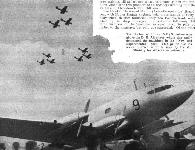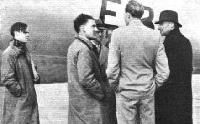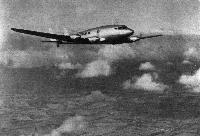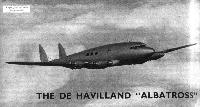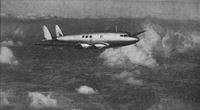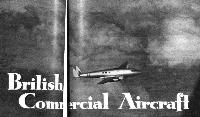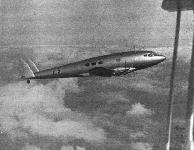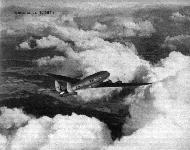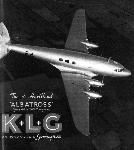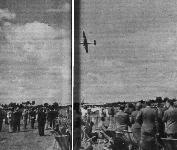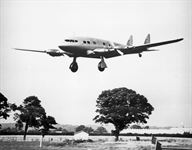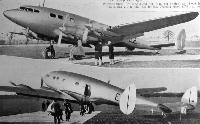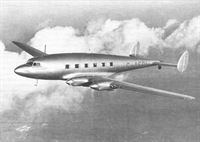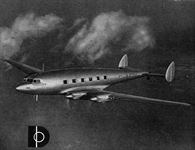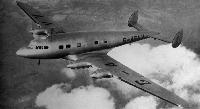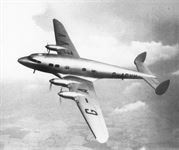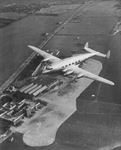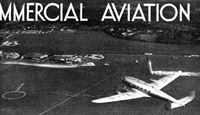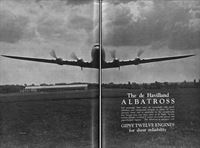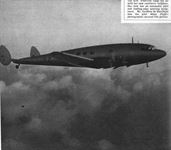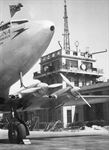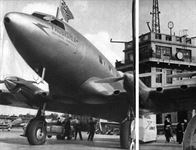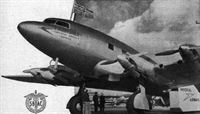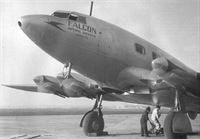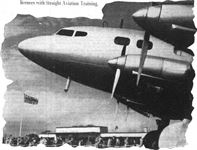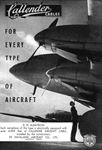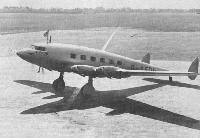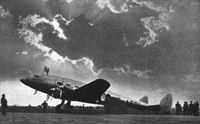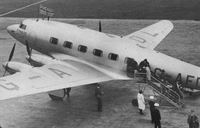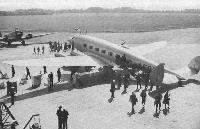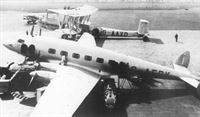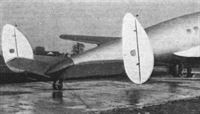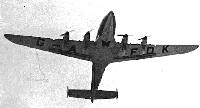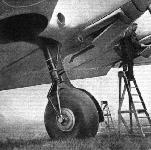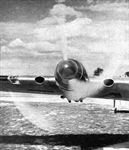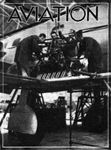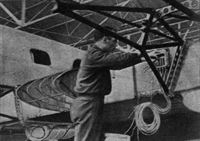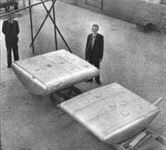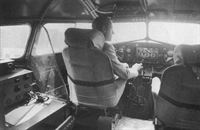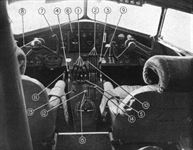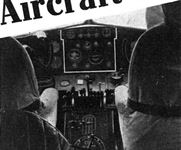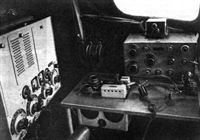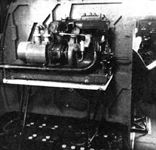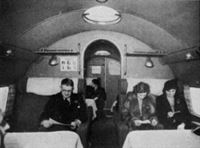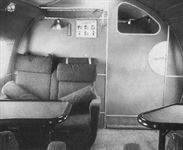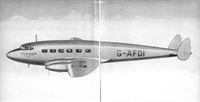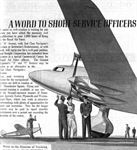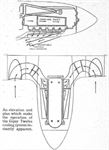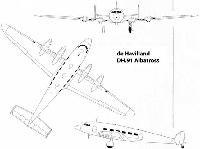
Описание
Страна : Великобритания
Год : 1937
Дальний транспортный самолет с экипажем из четырех человек
Albatross / D.H.91
de Havilland DH.91 Albatross
Разработанный А. Е. Хоггом в соответствии с требованиями Министерства авиации к трансатлантическому почтовому самолету, DH.91 Albatross имел самую совершенную аэродинамику среди всех коммерческих машин предвоенного периода. Обшивка цельнодеревянного DH.91, представляла собой трехслойную "сэндвич-панель" (фанера/бальза/фанера), в дальнейшем успешно использовавшуюся на Mosquito. Неразъемное крыло имело конструкцию, аналогичную использовавшейся на DH.88. Силовая установка состояла из четырех двигателей Gipsy Twelve, приводивших винты с постоянной скоростью вращения. Основные стойки шасси убирались в крыло с помощью электропривода. Прототип, первоначально имевший два киля, установленных на полуразмахе стабилизатора, поднялся в воздух в Хэтфилде 20 мая 1937 года. Летные испытания выявили недостаточную эффективность вертикального оперения, и машина получила новое оперение, с концевыми шайбами и несбалансированными рулями направления и триммерами.
Проблемы с механизмом уборки шасси привели к аварийной посадке первого прототипа 31 марта 1938 года. Недостаточная прочность хвостовой части фюзеляжа была обнаружена после того, как второй прототип развалился надвое при посадке во время испытаний. Был внесен ряд доработок, и оба отремонтированных прототипа проходили экспериментальную эксплуатацию в авиакомпании "Imperial Airways". Большая дальность полета (5359 км) делала их пригодными для полетов в Исландию, и в сентябре 1940 года самолеты были переданы 271-й эскадрилье ВВС. Пять Albatross, отличавшихся уменьшенной вместимостью, дополнительными иллюминаторами в кабине и щелевыми закрылками вместо разрезных, были переданы "Imperial Airways" в период с октября 1938 по июнь 1939 годов. Вмещавшие 22 пассажира и четырех членов экипажа, эти самолеты использовались во время войны на линиях, соединявших Бристоль с ирландским Шенноном и Лиссабоном в Португалии. После того, как число самолетов сократилось до двух из-за аварий и действий противника, они были списаны в сентябре 1943 года.
ТАКТИКО-ТЕХНИЧЕСКИЕ ХАРАКТЕРИСТИКИ
de Havilland DH.91 Albatross (пассажирский вариант)
Тип: дальний транспортный самолет с экипажем из четырех человек
Силовая установка: четыре рядных поршневых двигателя de Havilland Gipsy Twelve 1 мощностью по 525 л. с. (391 кВт)
Летные характеристики: максимальная скорость на оптимальной высоте 362 км/ч; крейсерская скорость на оптимальной высоте 338 км/ч; начальная скороподъемность 213 м/мин; потолок 5455 м; дальность полета (с пассажирами) 1674 км
Масса: пустого 9630 кг; максимальная взлетная 13381 кг
Размеры: размах крыла 32,00 м; длина 21,79 м; высота 6,78 м; площадь крыла 100,15 м2
Полезная нагрузка: до 22 пассажиров в закрытой кабине
Описание:
- Albatross / D.H.91
- Flight, October 1938
British Commercial Aircraft - Flight, November 1938
THE ALBATROSS in DETAIL
Фотографии
-
Мировая Авиация 105
Регистрационный номер: G-AFDM [2] Последними уцелевшими Albatross были лайнеры "Fiona" и "Falcon", к сожалению пущенные на слом во второй половине 1943 года.
-
Aeroplane Monthly 1985-12 / A.Lumsden, T.Heffernan - Probe Probare (19)
The prototype in its original form, photographed at Hatfield in mid-1937.
-
Flight 1937-07 / Flight
The Hectors of No. 13 (A.C.) Squadron seen above the D. H. Albatross, whose size easily dominated the machines in the "New and Experimental" park. This 91, to use its series number, is to be used by the Air Ministry for Atlantic experiments.
Другие самолёты на фотографии: Hawker Hector - Великобритания - 1936
-
Flight 1937-04 / Flight
The D.H. Albatross posed for photographs to show such features as the installation of the four Gipsy Twelves with their amazingly compact cowlings and leading-edge intakes for the cooling air, the retractable undercarriage and the general aerodynamic excellence of the whole machine.
-
Flight 1937-12 / Flight
The D.H. Gipsy Twelve air-cooled inverted vees in the D.H. Albatross are cooled on a new principle, air being taken in through ducts in the wing.
-
Flight 1937-04 / Flight
SAILOR BEWARE! A precursor of machines to span the Atlantic with heavy cargoes, the De Havilland Albatross, examples of which have been ordered by the Air Ministry for experimental flights between the Old and New Worlds, is one of the most striking British aircraft to be seen for many a year.
-
Aeroplane Monthly 1990-05 / J.Yoxall - Geoffrey de Havilland Jr /They who dared first/ (1)
De Havilland’s largest and smallest at Hatfield in September 1937. The T.K.4 stands beneath the undercarriage of its step-brother, the Albatross. R. J. Waight made the maiden flights of both these aircraft.
The diminutive 19ft 8in span T.K.4 nestles between the undercarriage of the 104ft 8in span D.H.91 Albatross. Empty, the T.K.4 weighed less than one of the D.H.91's Gipsy Twelve engines. After R. J. Waight was killed flying the T.K.4 Geoffrey de Havilland became chief test pilot.Другие самолёты на фотографии: De Havilland Technical School T.K.4 - Великобритания - 1937
-
Flight 1937-05 / Flight
The D.R Albatross is Capt. G. de Havilland's latest design.
-
Jane's All the World Aircraft 1980 / Encyclopedia of Aviation - Aircraft A-Z - v3
de Havilland D.H.91 Albatross.
-
Aeroplane Monthly 1990-06 / J.Stroud - Wings of Peace
The prototype Albatross in the SBAC line-up at Hendon on June 28, 1937. Beyond is RAS's D.H.86B Venus.
Другие самолёты на фотографии: De Havilland Express Air Liner / D.H.86 - Великобритания - 1934
-
Flight 1937-05 / Flight
The prototype ready for its first flight on May 20, 1937.
Watched by the majority of the D.H. employees, the Albatross is taxied in by Mr. Waight after its third test flight. Some idea of its exceptionally clean lines may be gathered from the flying picture above. -
Flight 1937-05 / Flight
7.15 a.m.: Discussions after the very first flight. In the main group, from left to right, are Mr. R. G. Waight (pilot), Mr. A. E. Hagg (designer), Mr. F. E. N. St. Barbe (business manager), Major F. B. Halford (engines) - the last two almost out of sight behind Mr. G. de Havilland, Junr. - and Capt. Geoffrey de Havilland. Standing modestly to the left is Mr. G. D. Tucker, who assisted Mr. Waight during the preliminary trials.
-
Flight 1937-10 / Flight
ON HER WAY: Trials of the De Havilland Albatross high-speed, long-range transport are still proceeding at Hatfield and this most beautiful of all large aeroplanes is frequently seen over Hertfordshire slipping along comfortably at her 210 m.p.h. cruising speed. This, her latest picture, was obtained during trials by Major Hereward de Havilland.
-
Flight 1937-06 / Flight
One of the most impressive transport aeroplanes ever built, the De Havilland Albatross is estimated to cruise at about 200 m.p.h. Its four engines are Gipsy Twelves.
-
Aeroplane Monthly 1990-06 / J.Stroud - Wings of Peace
The first Albatross on an early test flight. The strut-bracing of the original inset fins can be seen.
-
Flight 1938-04 / Flight
Outstanding among the landplanes is the D.H. Albatross, which makes use of the compact D.H. Gipsy Twelves. The tail is now cantilever with the fins and rudders at the extremities.
-
Flight 1937-12 / Flight
The de Havilland Albatross faced the camera in April and taxying tests commenced.
-
Flight 1937-07 / Flight
One of the two D.H. Albatross machines which have been ordered by the Air Ministry for transatlantic experiments. Their normal cruising speed is in the region of 210 m.p.h. at 10,000 ft.
-
Flight 1937-06 / Flight
TRANSCENDENT TRANSPORT: Perfection of line and an unsullied exterior combine to convey the impression that this is not an actual photograph but a spurious representation of the Albatross in flight, achieved with the aid of a model. In actual fact, this revealing picture of De Havillands' masterpiece was secured by Flight's photographer near Hatfield last week during a test flight by Mr. Waight.
-
Flight 1937-10 / Flight
The picture shown here of the De Havilland Albatross, undergoing routine tests for the Air Ministry, was taken on an exceptionally beautiful day for October, and to fly alongside this piece of silver loveliness against an ever-changing background of sunlight and shadow was sheer delight.
-
Flight 1937-11 / Flight
The first of the De Havilland Albatross inter-continental air liners on a test flight above the clouds.
-
Flight 1937-06 / Flight
EARMARKED: Anyone who had been out of touch with aeronautical developments might easily recognise the Albatross as a De Havilland product. Although more-or-less orthodox in lay-out this ninety-first De Havilland design features many structural innovations and very advanced power plant installations.
-
Flight 1937-07 / Flight Advertisements
The de Havilland Albatross Intercontinental Liner, powered by four de Havilland Gipsy Twelve engines driving de Havilland controllable constant-speed airscrews.
-
Aeroplane Monthly 1990-06 / J.Stroud - Wings of Peace
The elegance of the Albatross is very apparent in this photograph.
-
Flight 1937-07 / Flight
INCIDENTS at Hatfield last Tuesday: the De Havilland Albatross doing a steep bank against two of its engines;
-
Aeroplane Monthly 1981-10
The prototype D.H.91 Albatross landing back at Hatfield after an early test flight in mid-1937. E.2 is pictured with the original antiquated twin-fin arrangement. This was changed when early test flights disclosed a lack of rudder response in the climb.
-
Jane's All the World Aircraft 1938 / 03 - All the world's aeroplanes
Two views of the D.H. "Albatross" four-engined Long-range mail-carrier (four D.H. "Gips-Twelve" engines).
-
Aeroplane Monthly 1990-06 / J.Stroud - Wings of Peace
Регистрационный номер: G-AEVV [17] The first three examples of the Albatross at Hatfield. The second long-range aeroplane (unpainted) is nearest, with Frobisher in the centre and the prototype beyond.
-
Aeroplane Monthly 1985-12 / A.Lumsden, T.Heffernan - Probe Probare (19)
Регистрационный номер: G-AEVV [17] Предшественниками «Москито» были гражданские самолеты фирмы «Де Хэвилленд» DH.88 «Комета» и DH.91 «Альбатрос» (на фото)
The prototype Albatross with registration letters replacing the E.2 class B markings and with the revised tailplane, which not only cured the directional control problem but also greatly enhanced the aircraft’s appearance. -
Flight 1938-10 / Flight Advertisements
Регистрационный номер: G-AEVV [17] -
Aeroplane Monthly 1990-06 / J.Stroud - Wings of Peace
Регистрационный номер: G-AEVV [17] The prototype Albatross as G-AEVV. The beautiful fuselage lines are clearly seen, as well as the very cleanly installed engines.
-
Aviation Historian 24 / R.Pegram - Imperial Airways. The 1930s: a cause for concern?
Регистрационный номер: G-AEVV [17] With its slender, elegantly curving fuselage, shapely wings and extremely closely cowled streamlined Gipsy Twelve engines, the de Havilland D.H.91 Albatross was the very model of modernity when it entered Imperial Airways service in late 1938. All seven examples were transferred to the newly-minted BOAC in September 1940.
-
Air Enthusiast 2000-11 / G.Warner - Founding Fathers (2)
Регистрационный номер: G-AFDI [22] The shapely, but troublesome, DH.91 Albatross (G-AFDJ 'Frobisher' illustrated) was frustrated by the advent of the war.
Frobisher was flown at Martlesham in September and November 1938.
G-AFDI "Frobisher" the flagship of Imperial Airways' fleet of DH.91 Albatrosses, which was destroyed in an air raid at Whitchurch 20.10.40. Sadly only seven of these superb aircraft were ever built. -
Flight 1938-11 / Flight Advertisements
Регистрационный номер: G-AFDI [22] -
Flight 1938-10 / Flight
Регистрационный номер: G-AEVV [17] Probably the most efficient aircraft in the world, the D.H. Albatross flies at 210 m.p.h. on a cruising output of 1,302 h.p. from the four Gipsy Twelve engines this while carrying a disposable load of 11,638 lb. in the case of the transatlantic version, which is shown here. The range at the same power and loading against a 40 m.p.h. headwind is 2,500 miles.
-
Jane's All the World Aircraft 1938 / 03 - All the world's aeroplanes
Регистрационный номер: G-AEVV [17] The D.H. "Albatross" Four-engined Long-range Mail-carrier (four D.H. "Gips-Twelve" engines).
-
Aeroplane Monthly 1985-05 / K.Desmond - Arthur E. Hagg
Регистрационный номер: G-AEVV [17] The prototype D.H.91 Albatross, G-AEVV. Named Faraday, it served with Imperial Airways as a mail carrier from August 1939.
Perhaps the D.H.91 Albatross was Hagg's most beautiful design. Some say that its lines influenced the design of the Lockheed Constellation. -
Flight 1938-09 / Flight
Регистрационный номер: G-AEVV [17] SUITABLY STRENGTHENED: The second D.H. Albatross long-range monoplane is now flying, having been reinforced at the point in the fuselage which was found to be weak. All the passenger machines will be similarly strengthened. The reinforcement weighs only 12.5 lb.
-
Flight 1938-11 / Flight
Регистрационный номер: G-AEVV [17] The long-range D.H. Albatross, which will probably be the first machine to make serious use of both the Shannon Air Base and Collinstown, Dublin.
-
Flight 1940-08 / Flight Advertisements
Регистрационный номер: G-AFDI [22] ALBATROSS, 13 tons, 22 passengers, economical cruising 210 m.p.h., 338 km./hr.
-
Flight 1939-04 / Flight
Регистрационный номер: G-AEVV [17] FOUR-ENGINED FASHIONS: the De Havilland Albatross
-
Flight 1940-03 / Flight
Регистрационный номер: G-AFDI [22] The De Havilland Albatross is probably still the most efficient commercial aeroplane in the world.
-
Aeroplane Monthly 1990-06 / J.Stroud - Wings of Peace
Регистрационный номер: G-AEVV [17] AERODYNAMIC CLEANNESS. “The cruising speed of the D.H Albatross is 81 per cent, of what it would be if the machine were ideally streamlined."
Albatross G-AEVV, showing the finely tapered wing and dihedral tailplane. -
Aeroplane Monthly 1990-07 / J.Stroud - Wings of Peace
Регистрационный номер: G-AFDI [22] Frobisher over a deserted Croydon apron - although Lufthansa’s Junkers-Ju 52/3m D-AXAT Rudolf Windisch can be seen beneath Frobisher’s No 1 engine.
Другие самолёты на фотографии: Junkers Ju.52/3m - Германия - 1931
-
Flight 1938-11 / Flight
Регистрационный номер: G-AFDI [22] READY FOR SERVICE: The first of Imperial Airways’ D.H. Albatross series, Frobisher, arrives over its future home. The type will be used mainly on the London-Zurich service, where its high cruising speed should be appreciated.
-
Aeroplane Monthly 1990-06 / J.Stroud - Wings of Peace
Регистрационный номер: G-AEVV [17] The first Albatross, G-AEVV, over Hatfield Aerodrome on September 7, 1938. This was the first flight after fuselage modification following the August 27 incident.
-
Flight 1938-12 / Flight
Регистрационный номер: G-AEVV [17] LOOKING IT IN THE AIR-DUCTS: Mr. Geoffrey de Havilland, Jun., puts the Albatross into an advantageous position for Flight's chief photographer. In the distance is the new Reserve school building at Hatfield.
The D.H. Albatross (in the heading) probably represents the maximum aerodynamic efficiency attainable with a wing-fuselage combination. Further progress must be towards attaining the "all-wing" ideal. -
Flight 1938-06 / Flight Advertisements
Регистрационный номер: G-AEVV [17] -
Aeroplane Monthly 1990-06 / J.Stroud - Wings of Peace
The prototype Albatross with redesigned tail unit.
-
Flight 1938-02 / Flight
The D.H. Albatross takes the air with her new cantilever tailplane. She now has an automatic pilot and leading-edge anti-icing equipment. Mr. Geoffrey de Havilland was the pilot when Flight's photographer secured this picture.
-
Flight 1938-07 / Flight
This somewhat surrealistic impression at Ipswich suggests that the Albatross is trying to climb on to the airport roof to escape the militant attentions of the Sunderland and London (flying), Skua and Lysander.
Другие самолёты на фотографии: Blackburn Skua / B-24 - Великобритания - 1937Saunders-Roe London / A.27 - Великобритания - 1934Short Sunderland / S.25 - Великобритания - 1937Westland Lysander - Великобритания - 1936
-
Flight 1938-07 / Flight Advertisements
Регистрационный номер: G-AEVV [17] -
Flight 1938-04 / Flight
“A Government order for a transatlantic mail carrier, placed in 1936, provided a small part of the immense development cost of the Albatross.”
-
Aeroplane Monthly 1990-12 / P.Jarrett - Elsinore shows her colours
Регистрационный номер: G-AFDI [22] Elsinore in Imperial Airways livery at Croydon in November 1938. In the background stands D.H.91 Albatross G-AFDI Frobisher.
Другие самолёты на фотографии: Armstrong Whitworth Ensign / A.W.27 - Великобритания - 1938
-
Aeroplane Monthly 1974-05 / P.Moss - Wings for the Empire (5)
Регистрационный номер: G-AFDI [22] Frobisher and a pair of Ensigns at Croydon.
Другие самолёты на фотографии: Armstrong Whitworth Ensign / A.W.27 - Великобритания - 1938
-
Aeroplane Monthly 1974-05 / P.Moss - Wings for the Empire (5)
Регистрационный номер: G-AFDI [22] De Havilland D.H.91 G-AFDI Frobisher at Croydon
-
Aeroplane Monthly 1984-03 / Personal album
Регистрационный номер: G-AFDJ [5] D.H.91 Albatross G-AFDJ Falcon is seen at Eastleigh. 'DJ was built at Hatfield in 1938 and registered to Imperial Airways in November of that year. Five Albatross operated the Croydon-Paris, Brussels and Zurich routes until the outbreak of war, when all aircraft were evacuated to Bristol Whitchurch whence they operated on the Lisbon and Shannon shuttle services. After three of the fleet were lost in crashes the other two, including Falcon, were scrapped through lack of spares in September 1943.
-
Aeroplane Monthly 1984-03 / Personal album
Регистрационный номер: G-AFDJ [5] -
Aeroplane Monthly 1990-07 / J.Stroud - Wings of Peace
Регистрационный номер: G-AFDK [7] Fortuna with cabin, navigation and landing lights on.
-
Aeroplane Monthly 1984-11 / ??? - Fortuna
Регистрационный номер: G-AFDK [7] The unique plate of Fortuna comes to us from COLIN AMBROSE of West Vancouver. The photograph was taken at Croydon in 1939 but the photographer is not known.
-
Aeroplane Monthly 1984-11 / ??? - Fortuna
Регистрационный номер: G-AFDK [7] Fortuna seen at Hatfield in December 1938, before delivery to Imperial Airways. Note the three-bladed propellers.
-
Aviation Historian 24 / R.Pegram - Imperial Airways. The 1930s: a cause for concern?
Регистрационный номер: G-AFDI [22] The supremely graceful de Havilland D.H.91 Albatross was a shining symbol of British progress in airliner design during the 1930s - but the type suffered from structural problems and only seven were built. This example, G-AFDI Frobisher, awaits its next flight at Croydon in November 1938.
-
Flight 1938-11 / Flight Advertisements
Регистрационный номер: G-AFDI [22] -
Flight 1939-03 / Flight Advertisements
Регистрационный номер: G-AFDI [22] -
Flight 1940-04 / Flight
OUR END OF THE ATLANTIC SERVICE: Early next month will start a regular British service between London and Lisbon, linking there with the Pan American Atlantic. Recently an Albatross was flown to Lisbon experimentally, where it is seen at Sintra aerodrome with visitors and hosts. In the centre of the group is our Ambassador to Lisbon, Sir Walford Selby.
-
Aeroplane Monthly 1990-07 / J.Stroud - Wings of Peace
Регистрационный номер: G-AFDJ [5] 4 июня 1940г.: учитывая важность сообщения между Британией и США, авиакомпания BOAC приступила к выполнению дважды в неделю рейсов между Хестоном (Мидлсекс) и Лиссабоном (Португалия), используя самолет de Havilland DH.91 Albatross. Авиакомпания "Pan American" выполняла рейсы по маршруту Лиссабон - Нью-Йорк.
The undercarriage wells and inboard engine intakes are clearly visible in this view of Falcon. -
Aeroplane Monthly 1990-07 / J.Stroud - Wings of Peace
Регистрационный номер: G-AFDI [22] READY FOR ACTION: The first of the passenger-carrying D.H. Albatross monoplanes at Croydon last week. Suitably posed in the background will be seen Heracles, which has done so much good work and which will still be essential for dealing with the tremendous mail loads on the Empire routes during the Christmas season. Two of the D.H. Frobisher class are expected to be ready before the middle of December; afterwards they will be put on the Zurich route.
A contrast in styles. Imperial Airways D.H.91 Frobisher at Croydon in 1939 with the Handley Page H.P.45 Heracles.Другие самолёты на фотографии: Handley Page H.P.42 / H.P.45 - Великобритания - 1930
-
Flight 1938-10 / Flight
IN THEIR UNDERCOATS: Two D.H. Albatrosses, Imperial Airways’ Frobisher and one of the Air Ministry long-range jobs, seen out together at Hatfield last week.
-
Aeroplane Monthly 1976-03 / Personal album
Регистрационный номер: G-AFDL [3] Fine nostalgic photograph of the D.H.91 Albatross G-AFDL Fingal arriving at Croydon, probably in the summer of 1938. Only seven of these beautiful aircraft were built, and Imperial Airways began taking delivery of their "F" Class fleet in October 1938. Sadly, Fingal crash-landed near Pucklechurch, Glos, on October 6, 1940
-
Flight 1939-04 / Flight
Регистрационный номер: G-AFDI [22] Operating the world's fastest scheduled service - the D.H. Albatross, which cruises at 210 m.p.h., at Croydon.
-
Aeroplane Monthly 1984-11 / ??? - Fortuna
Регистрационный номер: G-AFDK [7] Fortuna at Croydon in 1939.
-
Aeroplane Monthly 1990-07 / J.Stroud - Wings of Peace
Регистрационный номер: G-AFDL [3] Passengers disembarking from Fingal at Croydon.
-
Flight 1939-06 / Flight
Регистрационный номер: G-AFDI [22] The D.H. Frobisher, one of a fleet of D.H. 91s used on the Paris service.
-
Aeroplane Monthly 1990-07 / J.Stroud - Wings of Peace
Регистрационный номер: G-AFDI [22] Frobisher pictured at Croydon.
-
Aeroplane Monthly 1976-03 / Personal album
Регистрационный номер: G-AFDI [22] -
Aeroplane Monthly 1990-07 / J.Stroud - Wings of Peace
Fingal or Fiona at Heston in the early days of the war.
"Fingal" at Heston after a trial flight to Lisbon in April 1940. Note the French recognition markings -
Flight 1939-01 / Flight
Регистрационный номер: G-AFDI [22] MAIL SPECIAL: One of the two Imperial F-class machines, the D.H. Falcon, at Alexandria after a fast flight from Croydon with Christmas mails. Each of the two Albatross machines which made the journey averaged just short of 219 m.p.h., while consuming only 78 gallons of fuel an hour (2.8 m.p.g.). Both Falcon and Frobisher weighed 13 tons at their take-off.
-
Aeroplane Monthly 1984-11 / ??? - Fortuna
Регистрационный номер: G-AFDK [7] Another view of Fortuna taken at Croydon with an H.P.42 and a D.H.86 in the background.
Другие самолёты на фотографии: De Havilland Express Air Liner / D.H.86 - Великобритания - 1934Handley Page H.P.42 / H.P.45 - Великобритания - 1930
-
Flight 1939-08 / Flight
IN SERVICE: The first Junkers Ju.90 to be seen in this country arrived on the normal Berlin-London run on August 1. The impressive size of this forty-seater is shown by the relative smallness of the Marcel Bloch on the right. The “accident” on the left is merely a group of Imperial machines, including two Frobisher-class and one Ensign-class liner. The Ju.90’s tail unit is interestingly complicated.
Другие самолёты на фотографии: Armstrong Whitworth Ensign / A.W.27 - Великобритания - 1938Bloch MB.220 - Франция - 1936Junkers Ju.90 - Германия - 1937
-
Aeroplane Monthly 1979-03 / R.Williams - Ensigns for the Empire (1)
Регистрационный номер: G-AFDJ [5] Croydon scene just before the war. In this view are the A.W.27s Ettrick, Elysian, Elsinore, Eddystone and Explorer, the D.H.91s Frobisher and Falcon, the H.P.45 Horatius and the Short L.17 Syrinx. Just visible in the background is a Junkers-Ju 90.
Imperial Airways airliners grounded at Croydon during the last month of peace had to stand in the open. Behind G-ADSX Ettrick can be seen G-ADSZ Elysian and G-ADST Elsinore.Другие самолёты на фотографии: Armstrong Whitworth Ensign / A.W.27 - Великобритания - 1938Handley Page H.P.42 / H.P.45 - Великобритания - 1930Junkers Ju.90 - Германия - 1937Short Scylla / L.17 - Великобритания - 1934
-
Flight 1938-02 / Flight
TAIL-PIECE: A close-up of the full cantilever tail of the D.H. Albatross. The rudders have been placed at the extreme tips, and the tailplane has a sharp dihedral. The modification is intended to ensure positive stability under all conditions of flight - this is particularly important for blind take-offs over a wide range of loadings and load dispositions.
-
Aeroplane Monthly 1990-07 / J.Stroud - Wings of Peace
Регистрационный номер: G-AFDK [7] Fiona in wartime camouflage.
View of "Fortuna" in 1943 awaiting departure time at Whitchurch; -
Air Pictorial 1964-09 / P.Moss - The de Havilland D.H.91 Albatross (2)
Регистрационный номер: G-AFDK [7] View of "Fortuna" in 1943 on her way to Shannon
-
Aeroplane Monthly 1990-07 / J.Stroud - Wings of Peace
Регистрационный номер: AX904 [2] Franklin, ex-G-AEVW, in full war camouflage as AX904 BJ-W.
-
Air Pictorial 1964-09 / P.Moss - The de Havilland D.H.91 Albatross (2)
Регистрационный номер: AX904 [2] "Franklin" camouflaged and in the markings of No. 271 Squadron during 1940
-
Air Pictorial 1964-09 / P.Moss - The de Havilland D.H.91 Albatross (2)
Регистрационный номер: G-AFDM [2] "Fiona" at Whitchurch in standard post-1940 camouflage
-
Flight 1940-02 / Flight
The DH Albatross undercarriage works by electrical retraction sideways and inwards into deep wheel wells.
-
Flight 1937-07 / Flight Advertisements
The de Havilland Company have once again shown their complete confidence in our equipment by selecting Dowty Oleo-Pneumatic Shock Absorber Struts for the main undercarriage and tail wheel for the "Albatross."
-
Aeroplane Monthly 1982-12 / B.Gunston - The classic aero engines (4)
A view of the 525 h.p. de Havilland Gipsy Twelve engine of a D.H.91 Albatross.
-
Flight 1938-03 / Flight
In this photograph the intake trunk from the leading edge to the cylinder banks can be seen. The picture, incidentally, shows how the whole installation of the inverted vee-twelve engine is little larger in diameter than the airscrew spinner.
-
Flight 1938-07 / Flight
The D.H. Gipsy Twelve installation, showing air duct entries set out at two-thirds of the airscrew diameter.
-
Aeroplane Monthly 1985-12 / A.Lumsden, T.Heffernan - Probe Probare (19)
One of the beautifully-cowled 525 h.p. Gipsy Twelve engines.
-
Flight 1938-07 / Flight
TRANSATLANTIC PREPARATION: One of the Gipsy Twelves being installed in the D.H. Albatross, two of which are to be used eventually for transatlantic experiments.
-
Aeroplane Monthly 1990-07 / J.Stroud - Wings of Peace
Регистрационный номер: G-AFDJ [5] How it might have been. One of the Frobishers with mock-up fuselage stripe. Although it has G-AFDJ on the fuselage it carried the name Frobisher (G-AFDI) on its nose.
-
Flight 1939-03 / Flight Advertisements
30,000 feet of Callender Aircraft Cable have been installed of this type built for Imperial Airways Ltd.
-
Flight 1938-11 / Flight
Two of the tanks for one of the long-range mail carriers acquired by the Air Ministry for trans-Atlantic work.
-
Flight 1937-06 / Flight
In the Bendix fluid-operated brake, as fitted to the D.H. Albatross, the piston in the operating cylinder forces apart two tappets which bear on the shoes.
-
Aeroplane Monthly 1990-07 / J.Stroud - Wings of Peace
The flight deck of a long-range Albatross with Geoffrey de Havilland Jr in the left-hand seat.
-
Flight 1938-11 / Flight
In comparison with the majority of modern control-cabin layouts in transport machines, that of the Albatross is extremely tidy. Most interesting, perhaps, is the layout of the engine and airscrew control bank, the flap and undercarriage operating gear and the trimming cranks. The undercarriage switch may be seen on the panel below that for the Sperry automatic pilot, while the flap switch and the rudder and aileron trimming cranks are arranged, with their appropriate indicators, below the engine and airscrew control levers. On the control bank are, left to right, landing light control, throttle and mixture, constant speed airscrew controls and automatic pilot cut-out. The fore and aft trimming wheel is on the left of the control bank. In the centre of the first pilot’s control half-spectacle will be seen the brake control lever, which is shown in the locked "on" position; when moved to the right the system is “free.”
-
Flight 1938-11 / Flight
No excuse is offered for publishing another photograph of the Albatross control cabin - which is tidier than some and simpler than most. Below is a key to the more important controls and instruments.
1. Throttles. 2. C.S. airscrew controls. 3. Automatic pilot cut-out. 4. Landing light control. 5. Mixture and slow-running cut-out controls. 6. Sperry pilot panel. 7. Instrument flying group. 8. Brake lever. 9. Revolution counters. 10. Undercarriage switch and indicator. 11. Fore and aft trimming wheel. 12. Fore and aft trimming indicator. 13. Flap operating switch. 14. Flap indicator. 15. Rudder and aileron trimming cranks. -
Flight 1938-10 / Flight Advertisements
1938 This photograph shows the Sperry Gyro Pilot installed in the De Havilland ALBATROSS. It will be noted that in the latest model the control units form part of the instrument panel and may be used by the pilot as blind flying instruments.
-
Flight 1938-12 / Flight Advertisements
A.R.E. 100. Short and Medium Wave Transmitter Receiver and Control Unit
-
Flight 1938-11 / Flight
The Marconi radio installation on the long-range mail carriers. On the left is an AD 67 A transmitter and on the right the receiver with medium/short wave homing equipment.
-
Flight 1938-11 / Flight
The little Stanley motor used for emergency wireless operation. This is exclusive to the long-range mail-carriers for the Air Ministry.
-
Aeroplane Monthly 1974-05 / P.Moss - Wings for the Empire (5)
Регистрационный номер: G-AFDI [22] The passenger cabin of the de Havilland D.H.91 G-AFDI Frobisher
-
Aeroplane Monthly 1990-07 / J.Stroud - Wings of Peace
Регистрационный номер: G-AFDI [22] View forward from the aft cabin of a Frobisher.
-
Aeroplane Monthly 1990-07 / J.Stroud - Wings of Peace
Регистрационный номер: G-AFDI [22] The rear cabin of a Frobisher, looking aft.
-
Flight 1938-11 / Flight
An artist’s impression of a cabin in the passenger-carrying version of the Albatross. Imperial Airways are having their own design of seat.
-
Aeroplane Monthly 1990-07 / J.Stroud - Wings of Peace
Регистрационный номер: G-AFDL [3] KEITH WOODCOCK'S painting shows the de Havilland Albatross Fingal in Imperial Airways livery - the first to use a brighter blue.
-
Aeroplane Monthly 1990-06 / J.Stroud - Wings of Peace
KEITH WOODCOCK'S painting shows the prototype Albatross landing at Hatfield in the summer of 1937.
-
Flight 1938-05 / Flight Advertisements
Регистрационный номер: G-AFDI [22] An impression of the first of the fleet of de Havilland Albatross high-speed liners shortly to be delivered to Imperial Airways.
-
Flight 1939-04 / Flight
The seating layout of the D.H. Albatross as arranged for Imperial Airways' European services.
-
Flight 1938-11 / Flight
A simple explanation of the cooling System employed for cooling the Gipsy Twelves on the Albatross. The air goes in the leading edge duct and is delivered to the engine from the rear, being exhausted through the adjustable outlet.
-
Flight 1938-03 / Flight
An elevation and plan which make the operation of the Gipsy Twelve cooling system instantly apparent.
-
Flight 1938-11 / Flight
One half of the retractable undercarriage on a mail-carrying Albatross. When retracted the wheels are moved in the belly of the fuselage.
-
Flight 1939-12 / Flight
Axial roller bearings (left) are used in Lockheed Airdraulic Cantilever shock absorber struts as fitted to the De Havilland Frobisher class of air liner (right).
-
Flight 1938-11 / Flight
A detail sketch showing the nature of the fuselage construction.
-
Flight 1938-11 / Flight
A makers’ representation of the speed efficiency of the Albatross in relation to its forerunner, the Comet racer. Particularly noteworthy is the reduction in engine drag.
Другие самолёты на фотографии: De Havilland Comet / D.H.88 - Великобритания - 1934
-
Flight 1938-11 / Flight
DE HAVILLAND ALBATROSS Four 432 h.p. (530 h.p. for takeoff) Gipsy Twelve engines.
-
Мировая Авиация 105
de Havilland DH.91 Albatross
Тип фотографий
- Все фото (137)
- Боковые проекции (1)
- Ч/б фото (108)
- Кабина (12)
- Рисунки, схемы (16)



